Corporate Finance Analysis: Risk Surfing Ltd Assignment
VerifiedAdded on 2023/01/06
|14
|2813
|52
Homework Assignment
AI Summary
This finance assignment solution addresses key concepts in corporate finance, including capital budgeting, capital structure, and working capital management. The document includes calculations for owners' equity, balance sheets, and net working capital. It explores return on assets, price-earnings ratios, and investment analysis, including calculations for investment choices, annual interest rates, and monthly payments. The assignment also covers portfolio analysis, beta calculations, and capital gains. Furthermore, it delves into bond pricing, share valuation, and capital structure, alongside the weighted average cost of capital (WACC) calculation. Finally, the document assesses equipment options using profitability index and discounted payback methods, providing a comprehensive overview of financial analysis and decision-making.
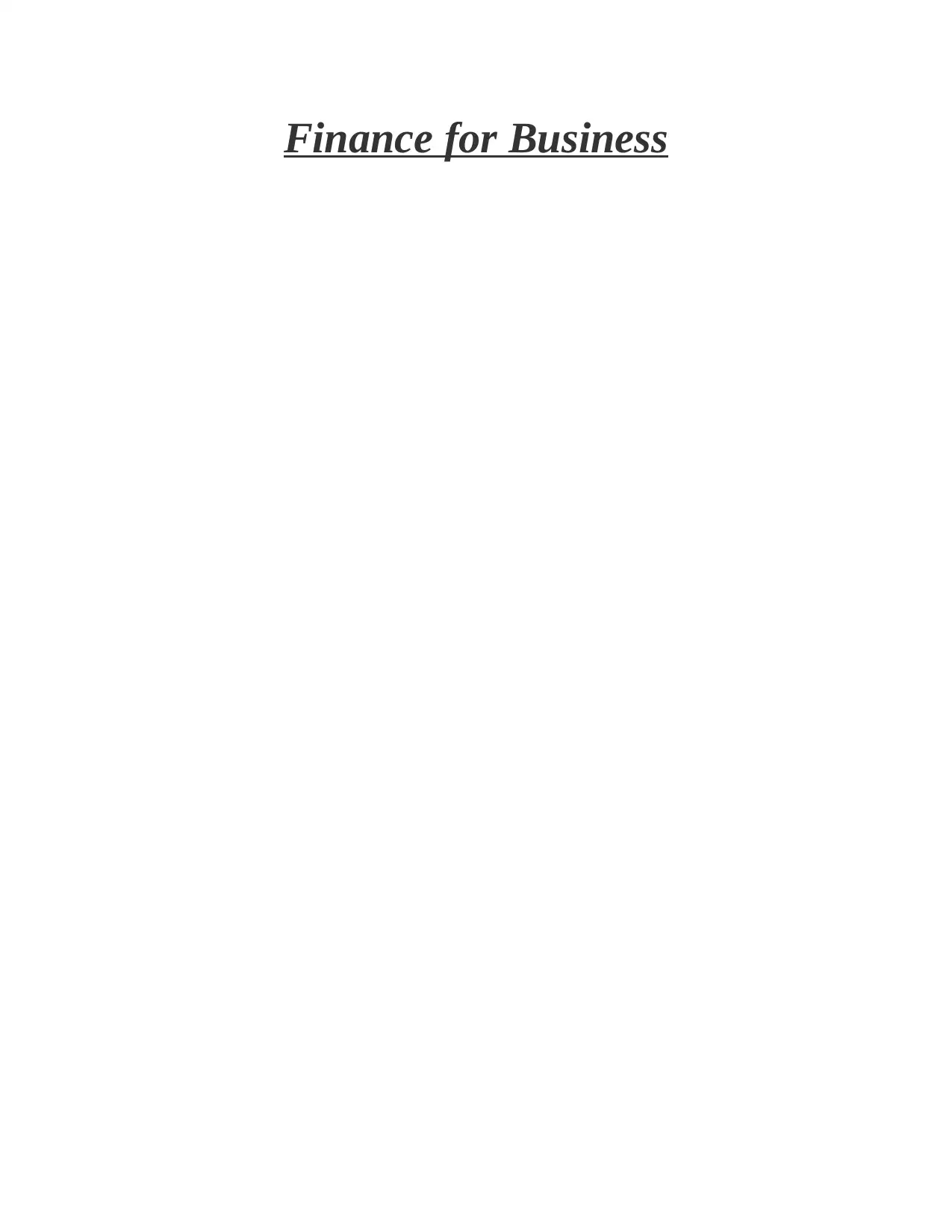
Finance for Business
Paraphrase This Document
Need a fresh take? Get an instant paraphrase of this document with our AI Paraphraser
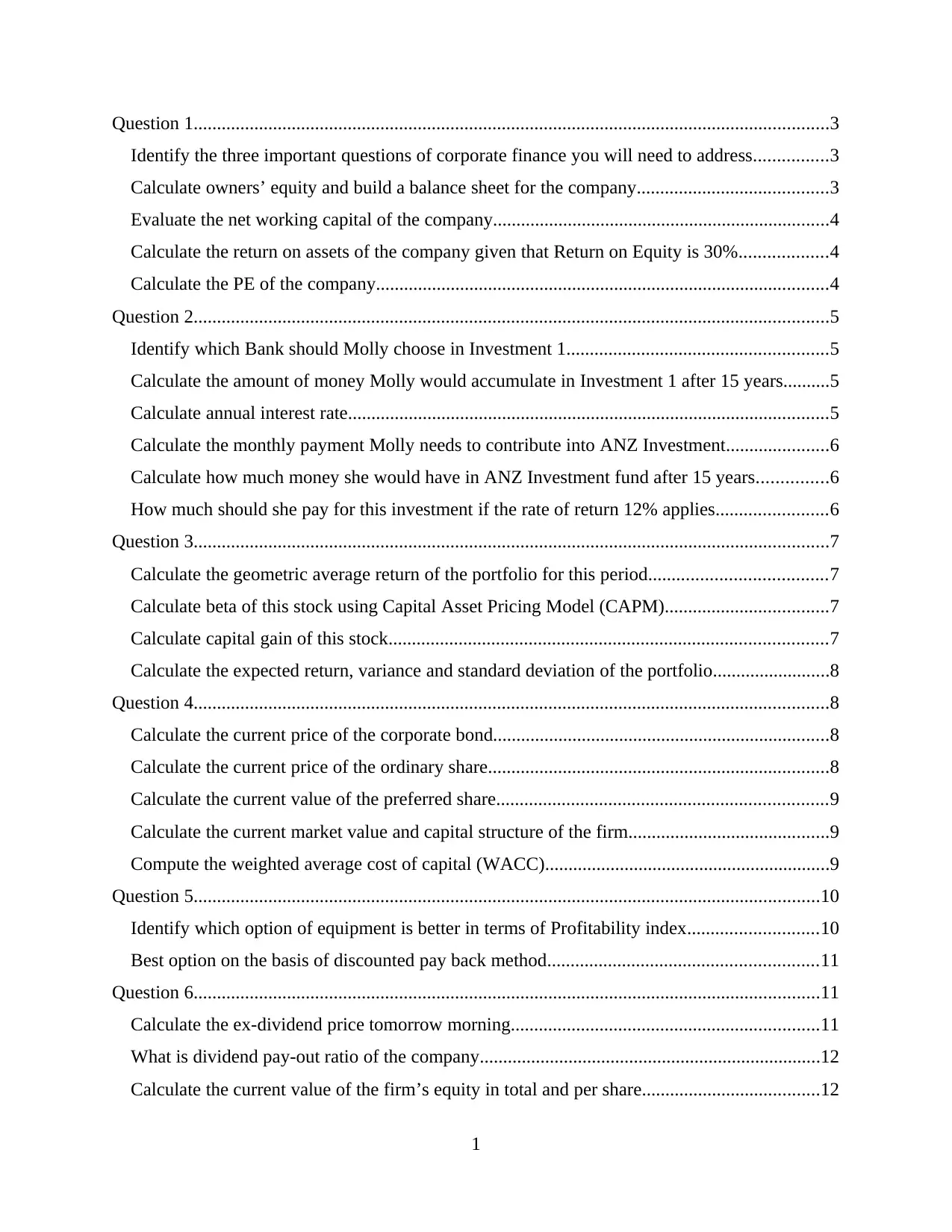
Question 1........................................................................................................................................3
Identify the three important questions of corporate finance you will need to address................3
Calculate owners’ equity and build a balance sheet for the company.........................................3
Evaluate the net working capital of the company........................................................................4
Calculate the return on assets of the company given that Return on Equity is 30%...................4
Calculate the PE of the company.................................................................................................4
Question 2........................................................................................................................................5
Identify which Bank should Molly choose in Investment 1........................................................5
Calculate the amount of money Molly would accumulate in Investment 1 after 15 years..........5
Calculate annual interest rate.......................................................................................................5
Calculate the monthly payment Molly needs to contribute into ANZ Investment......................6
Calculate how much money she would have in ANZ Investment fund after 15 years...............6
How much should she pay for this investment if the rate of return 12% applies........................6
Question 3........................................................................................................................................7
Calculate the geometric average return of the portfolio for this period......................................7
Calculate beta of this stock using Capital Asset Pricing Model (CAPM)...................................7
Calculate capital gain of this stock..............................................................................................7
Calculate the expected return, variance and standard deviation of the portfolio.........................8
Question 4........................................................................................................................................8
Calculate the current price of the corporate bond........................................................................8
Calculate the current price of the ordinary share.........................................................................8
Calculate the current value of the preferred share.......................................................................9
Calculate the current market value and capital structure of the firm...........................................9
Compute the weighted average cost of capital (WACC).............................................................9
Question 5......................................................................................................................................10
Identify which option of equipment is better in terms of Profitability index............................10
Best option on the basis of discounted pay back method..........................................................11
Question 6......................................................................................................................................11
Calculate the ex-dividend price tomorrow morning..................................................................11
What is dividend pay-out ratio of the company.........................................................................12
Calculate the current value of the firm’s equity in total and per share......................................12
1
Identify the three important questions of corporate finance you will need to address................3
Calculate owners’ equity and build a balance sheet for the company.........................................3
Evaluate the net working capital of the company........................................................................4
Calculate the return on assets of the company given that Return on Equity is 30%...................4
Calculate the PE of the company.................................................................................................4
Question 2........................................................................................................................................5
Identify which Bank should Molly choose in Investment 1........................................................5
Calculate the amount of money Molly would accumulate in Investment 1 after 15 years..........5
Calculate annual interest rate.......................................................................................................5
Calculate the monthly payment Molly needs to contribute into ANZ Investment......................6
Calculate how much money she would have in ANZ Investment fund after 15 years...............6
How much should she pay for this investment if the rate of return 12% applies........................6
Question 3........................................................................................................................................7
Calculate the geometric average return of the portfolio for this period......................................7
Calculate beta of this stock using Capital Asset Pricing Model (CAPM)...................................7
Calculate capital gain of this stock..............................................................................................7
Calculate the expected return, variance and standard deviation of the portfolio.........................8
Question 4........................................................................................................................................8
Calculate the current price of the corporate bond........................................................................8
Calculate the current price of the ordinary share.........................................................................8
Calculate the current value of the preferred share.......................................................................9
Calculate the current market value and capital structure of the firm...........................................9
Compute the weighted average cost of capital (WACC).............................................................9
Question 5......................................................................................................................................10
Identify which option of equipment is better in terms of Profitability index............................10
Best option on the basis of discounted pay back method..........................................................11
Question 6......................................................................................................................................11
Calculate the ex-dividend price tomorrow morning..................................................................11
What is dividend pay-out ratio of the company.........................................................................12
Calculate the current value of the firm’s equity in total and per share......................................12
1
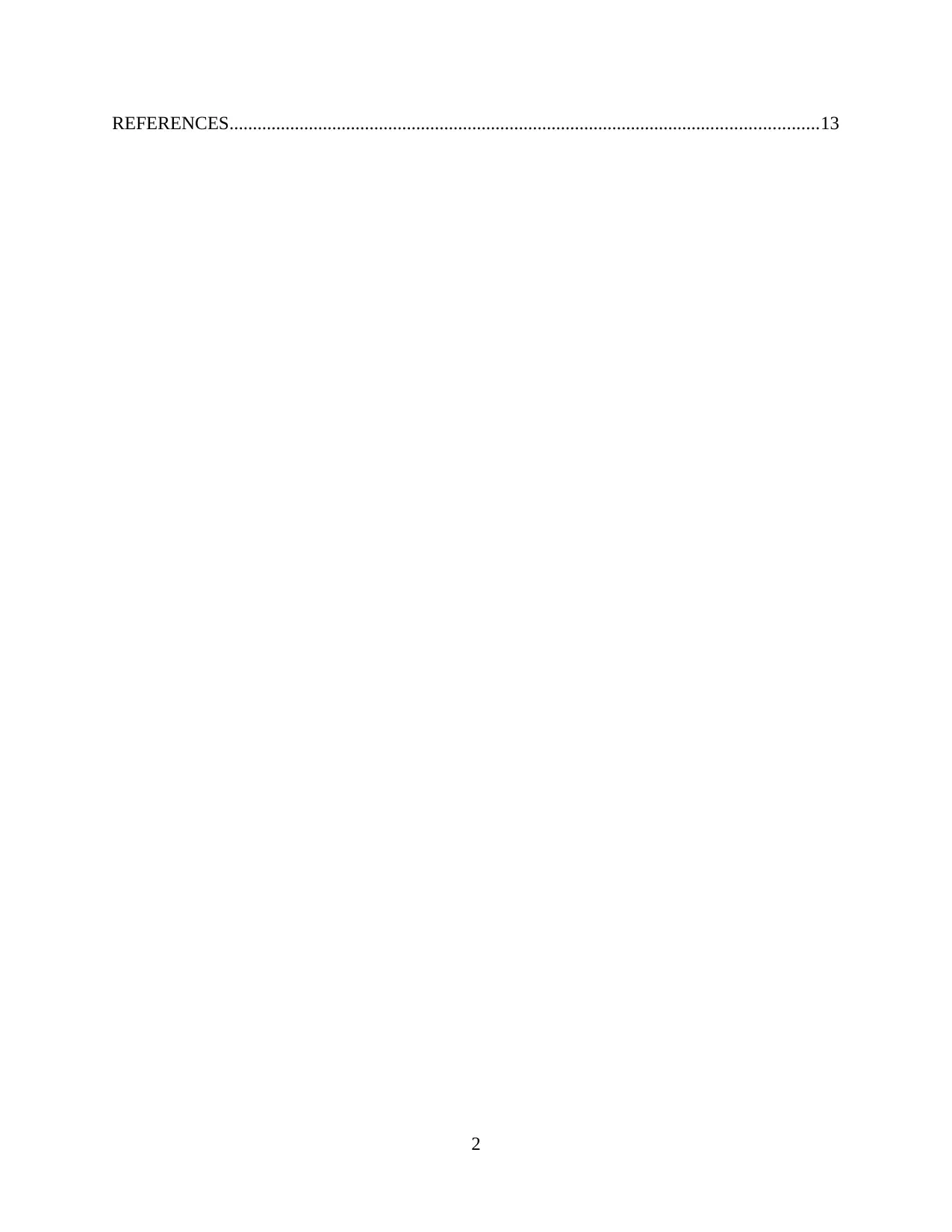
REFERENCES..............................................................................................................................13
2
2
You're viewing a preview
Unlock full access by subscribing today!
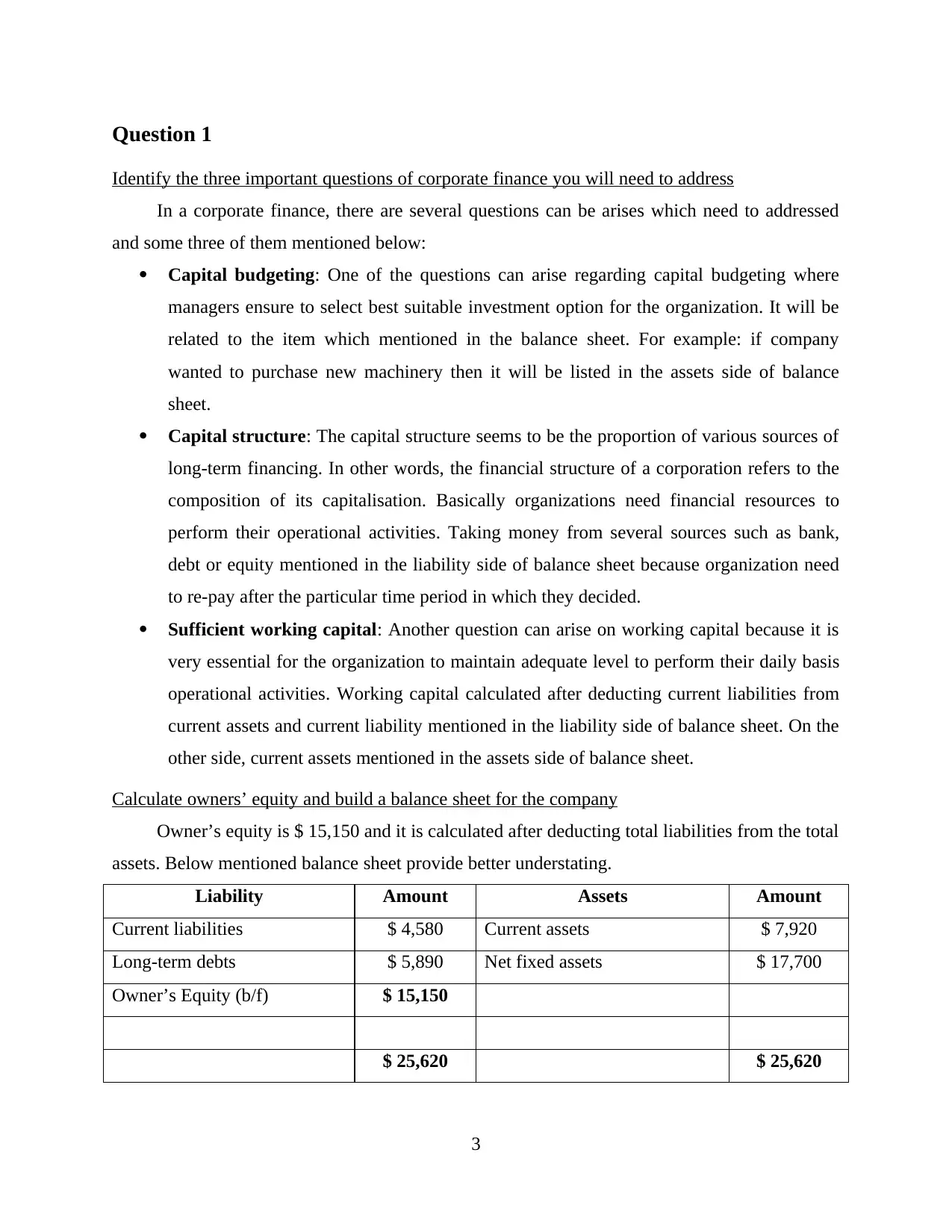
Question 1
Identify the three important questions of corporate finance you will need to address
In a corporate finance, there are several questions can be arises which need to addressed
and some three of them mentioned below:
Capital budgeting: One of the questions can arise regarding capital budgeting where
managers ensure to select best suitable investment option for the organization. It will be
related to the item which mentioned in the balance sheet. For example: if company
wanted to purchase new machinery then it will be listed in the assets side of balance
sheet.
Capital structure: The capital structure seems to be the proportion of various sources of
long-term financing. In other words, the financial structure of a corporation refers to the
composition of its capitalisation. Basically organizations need financial resources to
perform their operational activities. Taking money from several sources such as bank,
debt or equity mentioned in the liability side of balance sheet because organization need
to re-pay after the particular time period in which they decided.
Sufficient working capital: Another question can arise on working capital because it is
very essential for the organization to maintain adequate level to perform their daily basis
operational activities. Working capital calculated after deducting current liabilities from
current assets and current liability mentioned in the liability side of balance sheet. On the
other side, current assets mentioned in the assets side of balance sheet.
Calculate owners’ equity and build a balance sheet for the company
Owner’s equity is $ 15,150 and it is calculated after deducting total liabilities from the total
assets. Below mentioned balance sheet provide better understating.
Liability Amount Assets Amount
Current liabilities $ 4,580 Current assets $ 7,920
Long-term debts $ 5,890 Net fixed assets $ 17,700
Owner’s Equity (b/f) $ 15,150
$ 25,620 $ 25,620
3
Identify the three important questions of corporate finance you will need to address
In a corporate finance, there are several questions can be arises which need to addressed
and some three of them mentioned below:
Capital budgeting: One of the questions can arise regarding capital budgeting where
managers ensure to select best suitable investment option for the organization. It will be
related to the item which mentioned in the balance sheet. For example: if company
wanted to purchase new machinery then it will be listed in the assets side of balance
sheet.
Capital structure: The capital structure seems to be the proportion of various sources of
long-term financing. In other words, the financial structure of a corporation refers to the
composition of its capitalisation. Basically organizations need financial resources to
perform their operational activities. Taking money from several sources such as bank,
debt or equity mentioned in the liability side of balance sheet because organization need
to re-pay after the particular time period in which they decided.
Sufficient working capital: Another question can arise on working capital because it is
very essential for the organization to maintain adequate level to perform their daily basis
operational activities. Working capital calculated after deducting current liabilities from
current assets and current liability mentioned in the liability side of balance sheet. On the
other side, current assets mentioned in the assets side of balance sheet.
Calculate owners’ equity and build a balance sheet for the company
Owner’s equity is $ 15,150 and it is calculated after deducting total liabilities from the total
assets. Below mentioned balance sheet provide better understating.
Liability Amount Assets Amount
Current liabilities $ 4,580 Current assets $ 7,920
Long-term debts $ 5,890 Net fixed assets $ 17,700
Owner’s Equity (b/f) $ 15,150
$ 25,620 $ 25,620
3
Paraphrase This Document
Need a fresh take? Get an instant paraphrase of this document with our AI Paraphraser
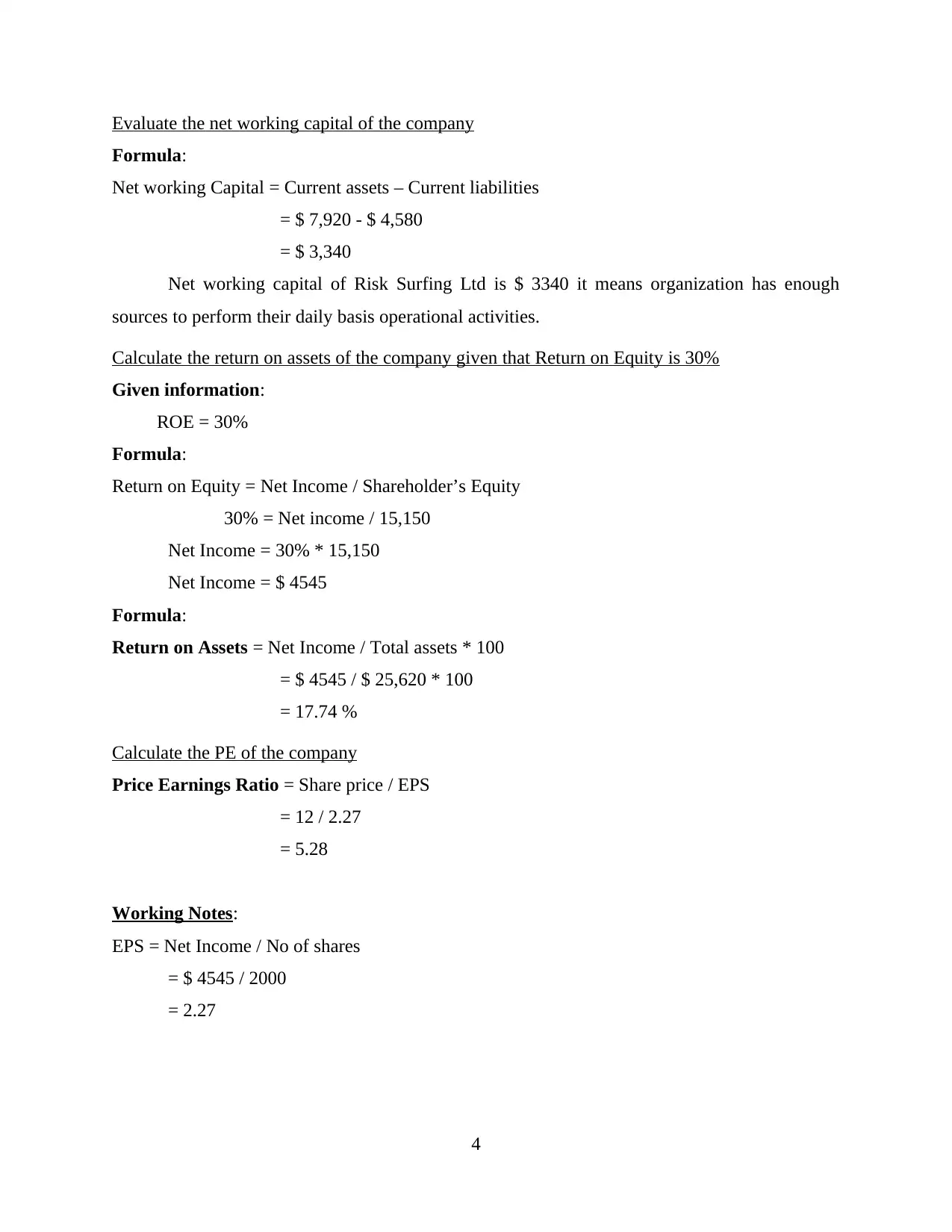
Evaluate the net working capital of the company
Formula:
Net working Capital = Current assets – Current liabilities
= $ 7,920 - $ 4,580
= $ 3,340
Net working capital of Risk Surfing Ltd is $ 3340 it means organization has enough
sources to perform their daily basis operational activities.
Calculate the return on assets of the company given that Return on Equity is 30%
Given information:
ROE = 30%
Formula:
Return on Equity = Net Income / Shareholder’s Equity
30% = Net income / 15,150
Net Income = 30% * 15,150
Net Income = $ 4545
Formula:
Return on Assets = Net Income / Total assets * 100
= $ 4545 / $ 25,620 * 100
= 17.74 %
Calculate the PE of the company
Price Earnings Ratio = Share price / EPS
= 12 / 2.27
= 5.28
Working Notes:
EPS = Net Income / No of shares
= $ 4545 / 2000
= 2.27
4
Formula:
Net working Capital = Current assets – Current liabilities
= $ 7,920 - $ 4,580
= $ 3,340
Net working capital of Risk Surfing Ltd is $ 3340 it means organization has enough
sources to perform their daily basis operational activities.
Calculate the return on assets of the company given that Return on Equity is 30%
Given information:
ROE = 30%
Formula:
Return on Equity = Net Income / Shareholder’s Equity
30% = Net income / 15,150
Net Income = 30% * 15,150
Net Income = $ 4545
Formula:
Return on Assets = Net Income / Total assets * 100
= $ 4545 / $ 25,620 * 100
= 17.74 %
Calculate the PE of the company
Price Earnings Ratio = Share price / EPS
= 12 / 2.27
= 5.28
Working Notes:
EPS = Net Income / No of shares
= $ 4545 / 2000
= 2.27
4
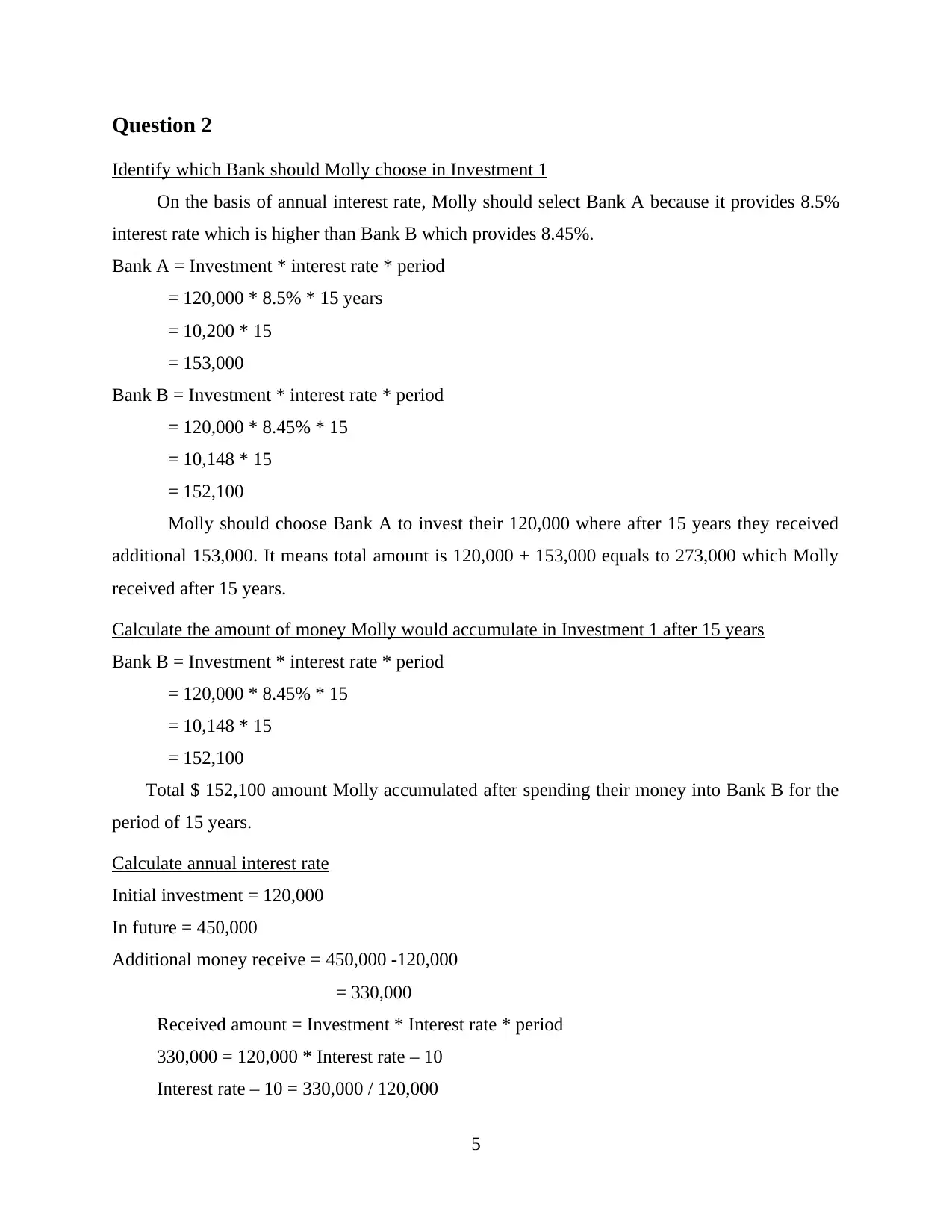
Question 2
Identify which Bank should Molly choose in Investment 1
On the basis of annual interest rate, Molly should select Bank A because it provides 8.5%
interest rate which is higher than Bank B which provides 8.45%.
Bank A = Investment * interest rate * period
= 120,000 * 8.5% * 15 years
= 10,200 * 15
= 153,000
Bank B = Investment * interest rate * period
= 120,000 * 8.45% * 15
= 10,148 * 15
= 152,100
Molly should choose Bank A to invest their 120,000 where after 15 years they received
additional 153,000. It means total amount is 120,000 + 153,000 equals to 273,000 which Molly
received after 15 years.
Calculate the amount of money Molly would accumulate in Investment 1 after 15 years
Bank B = Investment * interest rate * period
= 120,000 * 8.45% * 15
= 10,148 * 15
= 152,100
Total $ 152,100 amount Molly accumulated after spending their money into Bank B for the
period of 15 years.
Calculate annual interest rate
Initial investment = 120,000
In future = 450,000
Additional money receive = 450,000 -120,000
= 330,000
Received amount = Investment * Interest rate * period
330,000 = 120,000 * Interest rate – 10
Interest rate – 10 = 330,000 / 120,000
5
Identify which Bank should Molly choose in Investment 1
On the basis of annual interest rate, Molly should select Bank A because it provides 8.5%
interest rate which is higher than Bank B which provides 8.45%.
Bank A = Investment * interest rate * period
= 120,000 * 8.5% * 15 years
= 10,200 * 15
= 153,000
Bank B = Investment * interest rate * period
= 120,000 * 8.45% * 15
= 10,148 * 15
= 152,100
Molly should choose Bank A to invest their 120,000 where after 15 years they received
additional 153,000. It means total amount is 120,000 + 153,000 equals to 273,000 which Molly
received after 15 years.
Calculate the amount of money Molly would accumulate in Investment 1 after 15 years
Bank B = Investment * interest rate * period
= 120,000 * 8.45% * 15
= 10,148 * 15
= 152,100
Total $ 152,100 amount Molly accumulated after spending their money into Bank B for the
period of 15 years.
Calculate annual interest rate
Initial investment = 120,000
In future = 450,000
Additional money receive = 450,000 -120,000
= 330,000
Received amount = Investment * Interest rate * period
330,000 = 120,000 * Interest rate – 10
Interest rate – 10 = 330,000 / 120,000
5
You're viewing a preview
Unlock full access by subscribing today!
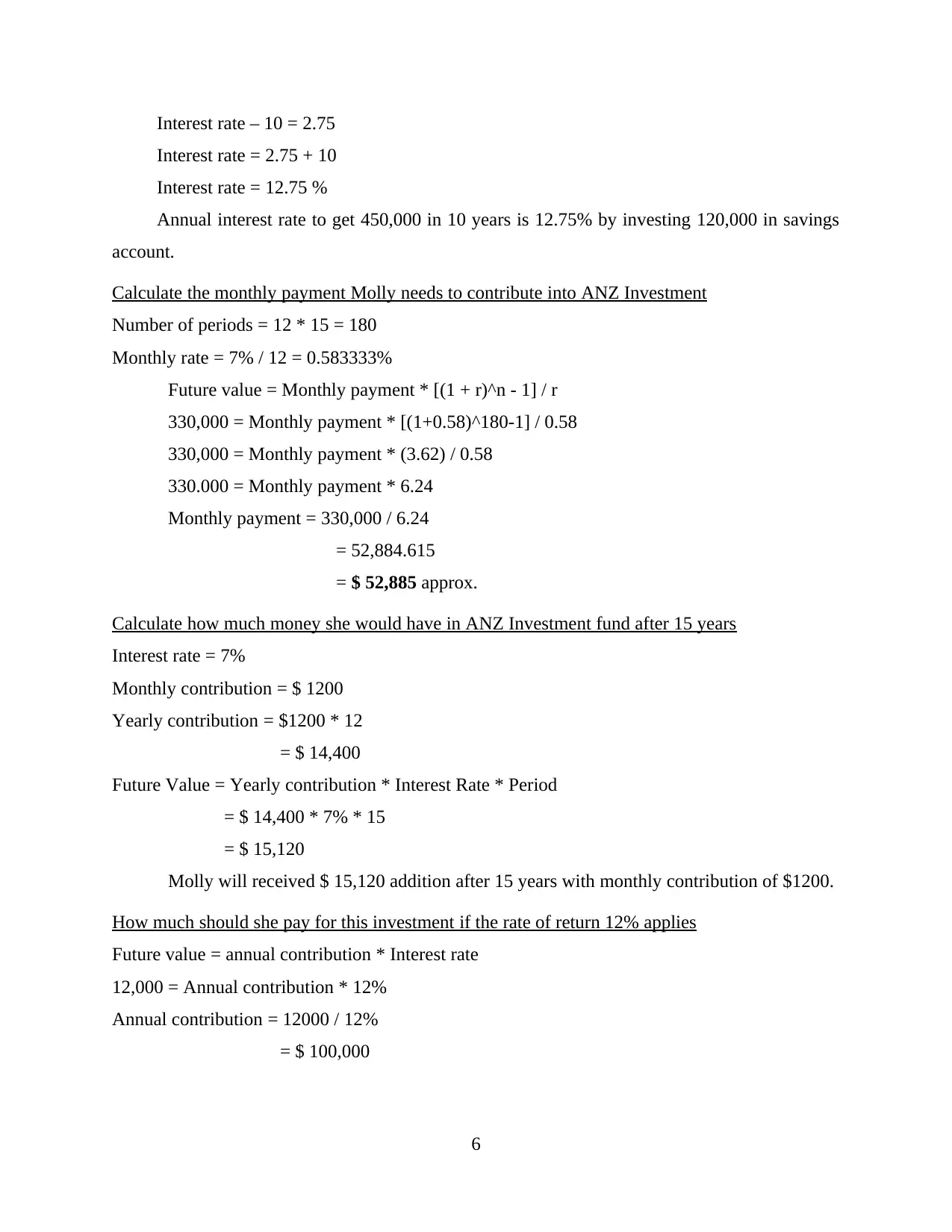
Interest rate – 10 = 2.75
Interest rate = 2.75 + 10
Interest rate = 12.75 %
Annual interest rate to get 450,000 in 10 years is 12.75% by investing 120,000 in savings
account.
Calculate the monthly payment Molly needs to contribute into ANZ Investment
Number of periods = 12 * 15 = 180
Monthly rate = 7% / 12 = 0.583333%
Future value = Monthly payment * [(1 + r)^n - 1] / r
330,000 = Monthly payment * [(1+0.58)^180-1] / 0.58
330,000 = Monthly payment * (3.62) / 0.58
330.000 = Monthly payment * 6.24
Monthly payment = 330,000 / 6.24
= 52,884.615
= $ 52,885 approx.
Calculate how much money she would have in ANZ Investment fund after 15 years
Interest rate = 7%
Monthly contribution = $ 1200
Yearly contribution = $1200 * 12
= $ 14,400
Future Value = Yearly contribution * Interest Rate * Period
= $ 14,400 * 7% * 15
= $ 15,120
Molly will received $ 15,120 addition after 15 years with monthly contribution of $1200.
How much should she pay for this investment if the rate of return 12% applies
Future value = annual contribution * Interest rate
12,000 = Annual contribution * 12%
Annual contribution = 12000 / 12%
= $ 100,000
6
Interest rate = 2.75 + 10
Interest rate = 12.75 %
Annual interest rate to get 450,000 in 10 years is 12.75% by investing 120,000 in savings
account.
Calculate the monthly payment Molly needs to contribute into ANZ Investment
Number of periods = 12 * 15 = 180
Monthly rate = 7% / 12 = 0.583333%
Future value = Monthly payment * [(1 + r)^n - 1] / r
330,000 = Monthly payment * [(1+0.58)^180-1] / 0.58
330,000 = Monthly payment * (3.62) / 0.58
330.000 = Monthly payment * 6.24
Monthly payment = 330,000 / 6.24
= 52,884.615
= $ 52,885 approx.
Calculate how much money she would have in ANZ Investment fund after 15 years
Interest rate = 7%
Monthly contribution = $ 1200
Yearly contribution = $1200 * 12
= $ 14,400
Future Value = Yearly contribution * Interest Rate * Period
= $ 14,400 * 7% * 15
= $ 15,120
Molly will received $ 15,120 addition after 15 years with monthly contribution of $1200.
How much should she pay for this investment if the rate of return 12% applies
Future value = annual contribution * Interest rate
12,000 = Annual contribution * 12%
Annual contribution = 12000 / 12%
= $ 100,000
6
Paraphrase This Document
Need a fresh take? Get an instant paraphrase of this document with our AI Paraphraser
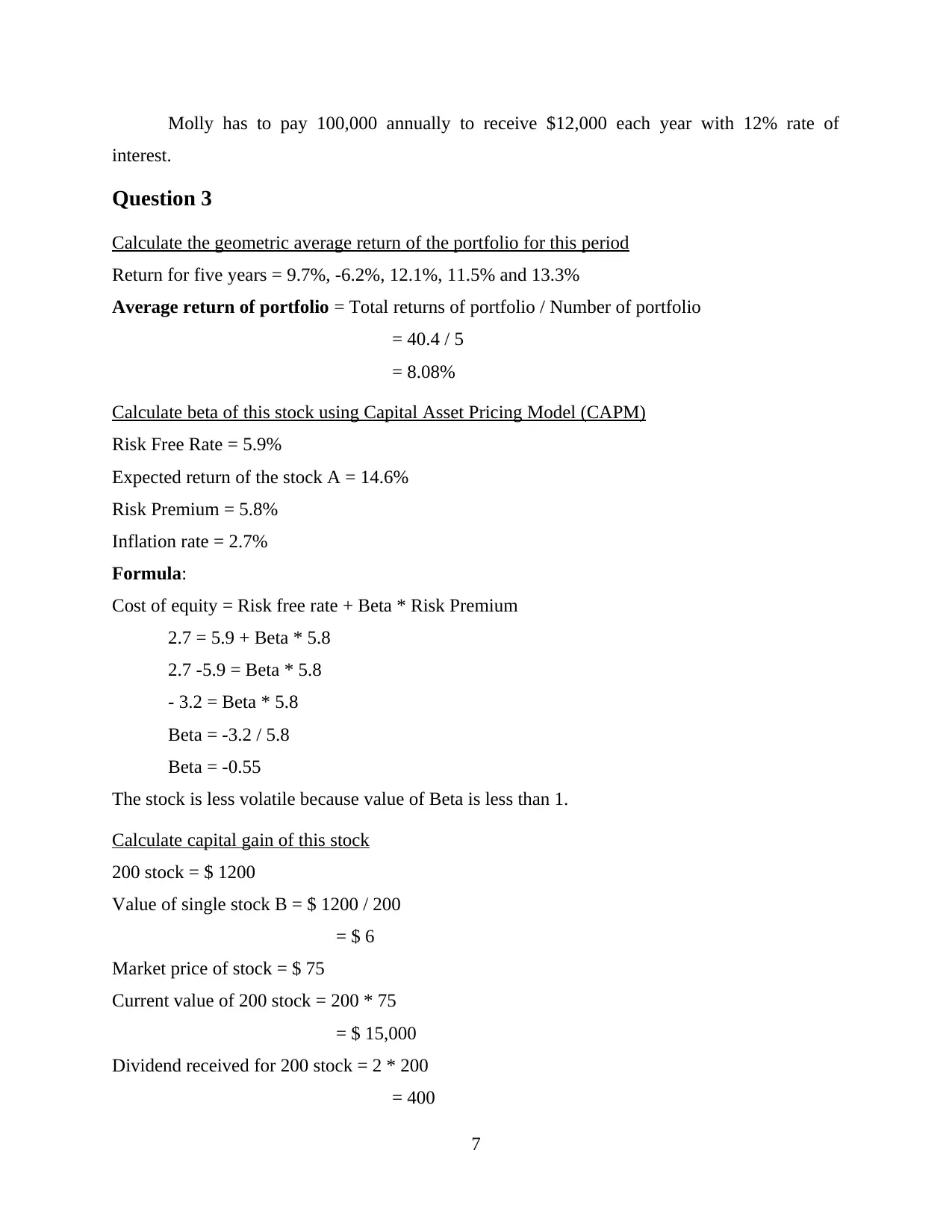
Molly has to pay 100,000 annually to receive $12,000 each year with 12% rate of
interest.
Question 3
Calculate the geometric average return of the portfolio for this period
Return for five years = 9.7%, -6.2%, 12.1%, 11.5% and 13.3%
Average return of portfolio = Total returns of portfolio / Number of portfolio
= 40.4 / 5
= 8.08%
Calculate beta of this stock using Capital Asset Pricing Model (CAPM)
Risk Free Rate = 5.9%
Expected return of the stock A = 14.6%
Risk Premium = 5.8%
Inflation rate = 2.7%
Formula:
Cost of equity = Risk free rate + Beta * Risk Premium
2.7 = 5.9 + Beta * 5.8
2.7 -5.9 = Beta * 5.8
- 3.2 = Beta * 5.8
Beta = -3.2 / 5.8
Beta = -0.55
The stock is less volatile because value of Beta is less than 1.
Calculate capital gain of this stock
200 stock = $ 1200
Value of single stock B = $ 1200 / 200
= $ 6
Market price of stock = $ 75
Current value of 200 stock = 200 * 75
= $ 15,000
Dividend received for 200 stock = 2 * 200
= 400
7
interest.
Question 3
Calculate the geometric average return of the portfolio for this period
Return for five years = 9.7%, -6.2%, 12.1%, 11.5% and 13.3%
Average return of portfolio = Total returns of portfolio / Number of portfolio
= 40.4 / 5
= 8.08%
Calculate beta of this stock using Capital Asset Pricing Model (CAPM)
Risk Free Rate = 5.9%
Expected return of the stock A = 14.6%
Risk Premium = 5.8%
Inflation rate = 2.7%
Formula:
Cost of equity = Risk free rate + Beta * Risk Premium
2.7 = 5.9 + Beta * 5.8
2.7 -5.9 = Beta * 5.8
- 3.2 = Beta * 5.8
Beta = -3.2 / 5.8
Beta = -0.55
The stock is less volatile because value of Beta is less than 1.
Calculate capital gain of this stock
200 stock = $ 1200
Value of single stock B = $ 1200 / 200
= $ 6
Market price of stock = $ 75
Current value of 200 stock = 200 * 75
= $ 15,000
Dividend received for 200 stock = 2 * 200
= 400
7
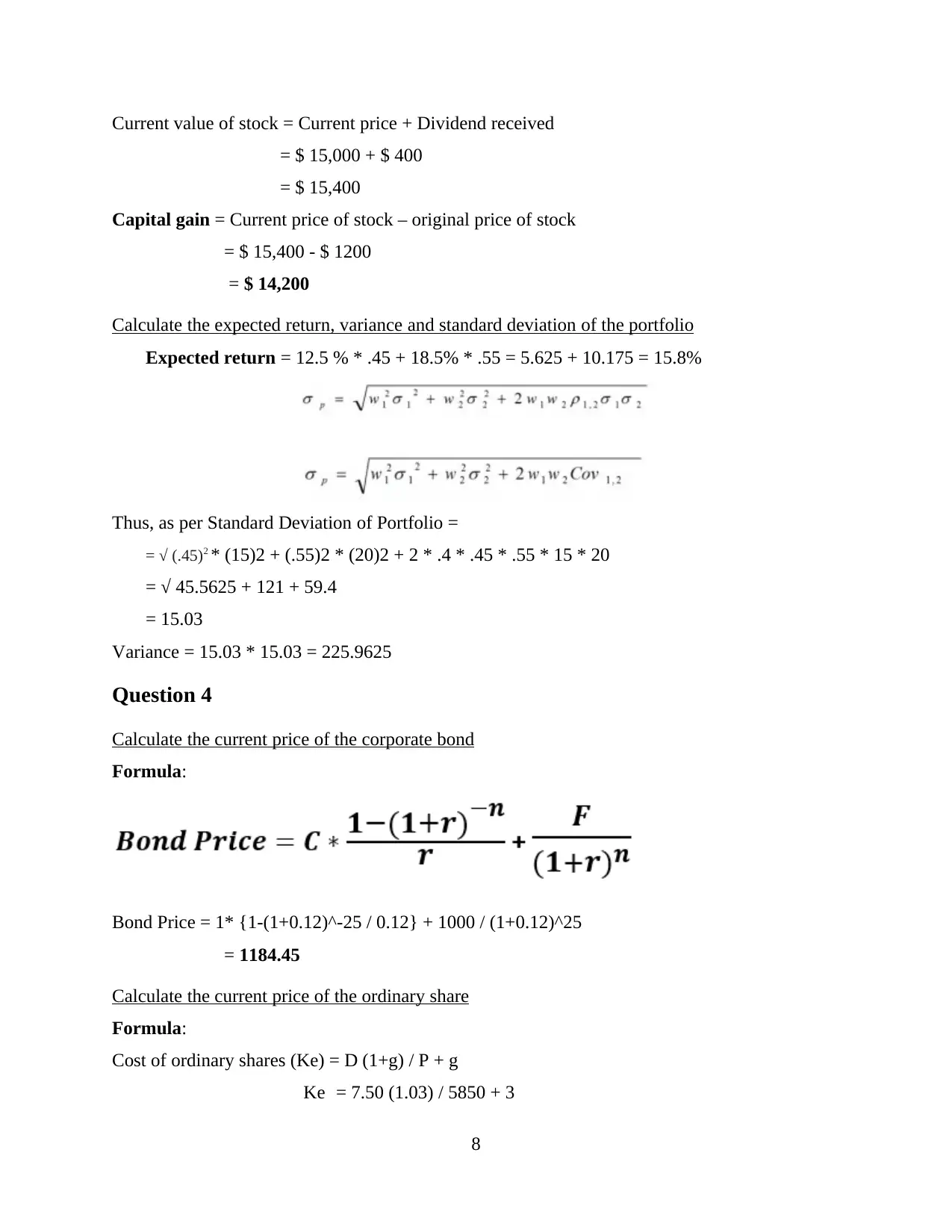
Current value of stock = Current price + Dividend received
= $ 15,000 + $ 400
= $ 15,400
Capital gain = Current price of stock – original price of stock
= $ 15,400 - $ 1200
= $ 14,200
Calculate the expected return, variance and standard deviation of the portfolio
Expected return = 12.5 % * .45 + 18.5% * .55 = 5.625 + 10.175 = 15.8%
Thus, as per Standard Deviation of Portfolio =
= √ (.45)2 * (15)2 + (.55)2 * (20)2 + 2 * .4 * .45 * .55 * 15 * 20
= √ 45.5625 + 121 + 59.4
= 15.03
Variance = 15.03 * 15.03 = 225.9625
Question 4
Calculate the current price of the corporate bond
Formula:
Bond Price = 1* {1-(1+0.12)^-25 / 0.12} + 1000 / (1+0.12)^25
= 1184.45
Calculate the current price of the ordinary share
Formula:
Cost of ordinary shares (Ke) = D (1+g) / P + g
Ke = 7.50 (1.03) / 5850 + 3
8
= $ 15,000 + $ 400
= $ 15,400
Capital gain = Current price of stock – original price of stock
= $ 15,400 - $ 1200
= $ 14,200
Calculate the expected return, variance and standard deviation of the portfolio
Expected return = 12.5 % * .45 + 18.5% * .55 = 5.625 + 10.175 = 15.8%
Thus, as per Standard Deviation of Portfolio =
= √ (.45)2 * (15)2 + (.55)2 * (20)2 + 2 * .4 * .45 * .55 * 15 * 20
= √ 45.5625 + 121 + 59.4
= 15.03
Variance = 15.03 * 15.03 = 225.9625
Question 4
Calculate the current price of the corporate bond
Formula:
Bond Price = 1* {1-(1+0.12)^-25 / 0.12} + 1000 / (1+0.12)^25
= 1184.45
Calculate the current price of the ordinary share
Formula:
Cost of ordinary shares (Ke) = D (1+g) / P + g
Ke = 7.50 (1.03) / 5850 + 3
8
You're viewing a preview
Unlock full access by subscribing today!
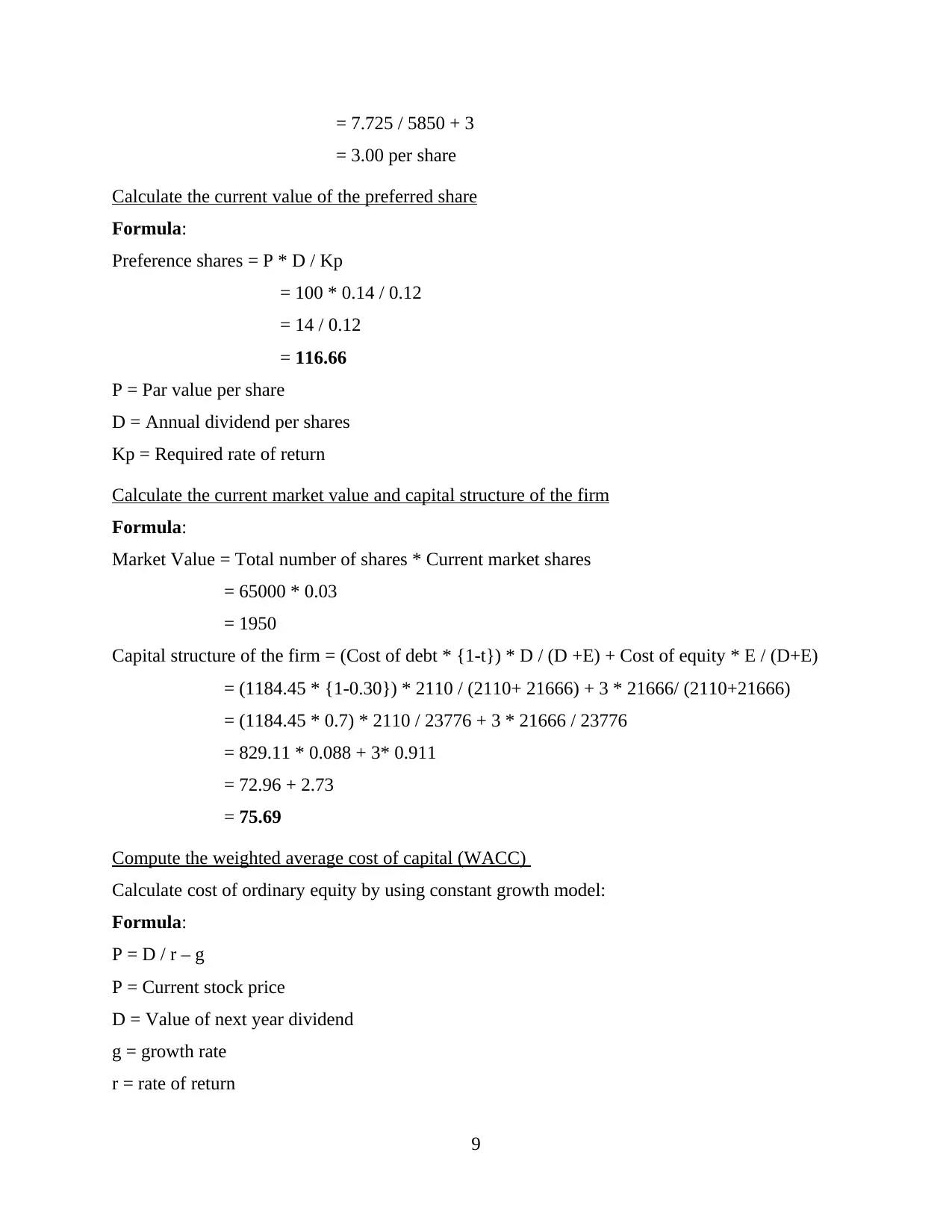
= 7.725 / 5850 + 3
= 3.00 per share
Calculate the current value of the preferred share
Formula:
Preference shares = P * D / Kp
= 100 * 0.14 / 0.12
= 14 / 0.12
= 116.66
P = Par value per share
D = Annual dividend per shares
Kp = Required rate of return
Calculate the current market value and capital structure of the firm
Formula:
Market Value = Total number of shares * Current market shares
= 65000 * 0.03
= 1950
Capital structure of the firm = (Cost of debt * {1-t}) * D / (D +E) + Cost of equity * E / (D+E)
= (1184.45 * {1-0.30}) * 2110 / (2110+ 21666) + 3 * 21666/ (2110+21666)
= (1184.45 * 0.7) * 2110 / 23776 + 3 * 21666 / 23776
= 829.11 * 0.088 + 3* 0.911
= 72.96 + 2.73
= 75.69
Compute the weighted average cost of capital (WACC)
Calculate cost of ordinary equity by using constant growth model:
Formula:
P = D / r – g
P = Current stock price
D = Value of next year dividend
g = growth rate
r = rate of return
9
= 3.00 per share
Calculate the current value of the preferred share
Formula:
Preference shares = P * D / Kp
= 100 * 0.14 / 0.12
= 14 / 0.12
= 116.66
P = Par value per share
D = Annual dividend per shares
Kp = Required rate of return
Calculate the current market value and capital structure of the firm
Formula:
Market Value = Total number of shares * Current market shares
= 65000 * 0.03
= 1950
Capital structure of the firm = (Cost of debt * {1-t}) * D / (D +E) + Cost of equity * E / (D+E)
= (1184.45 * {1-0.30}) * 2110 / (2110+ 21666) + 3 * 21666/ (2110+21666)
= (1184.45 * 0.7) * 2110 / 23776 + 3 * 21666 / 23776
= 829.11 * 0.088 + 3* 0.911
= 72.96 + 2.73
= 75.69
Compute the weighted average cost of capital (WACC)
Calculate cost of ordinary equity by using constant growth model:
Formula:
P = D / r – g
P = Current stock price
D = Value of next year dividend
g = growth rate
r = rate of return
9
Paraphrase This Document
Need a fresh take? Get an instant paraphrase of this document with our AI Paraphraser
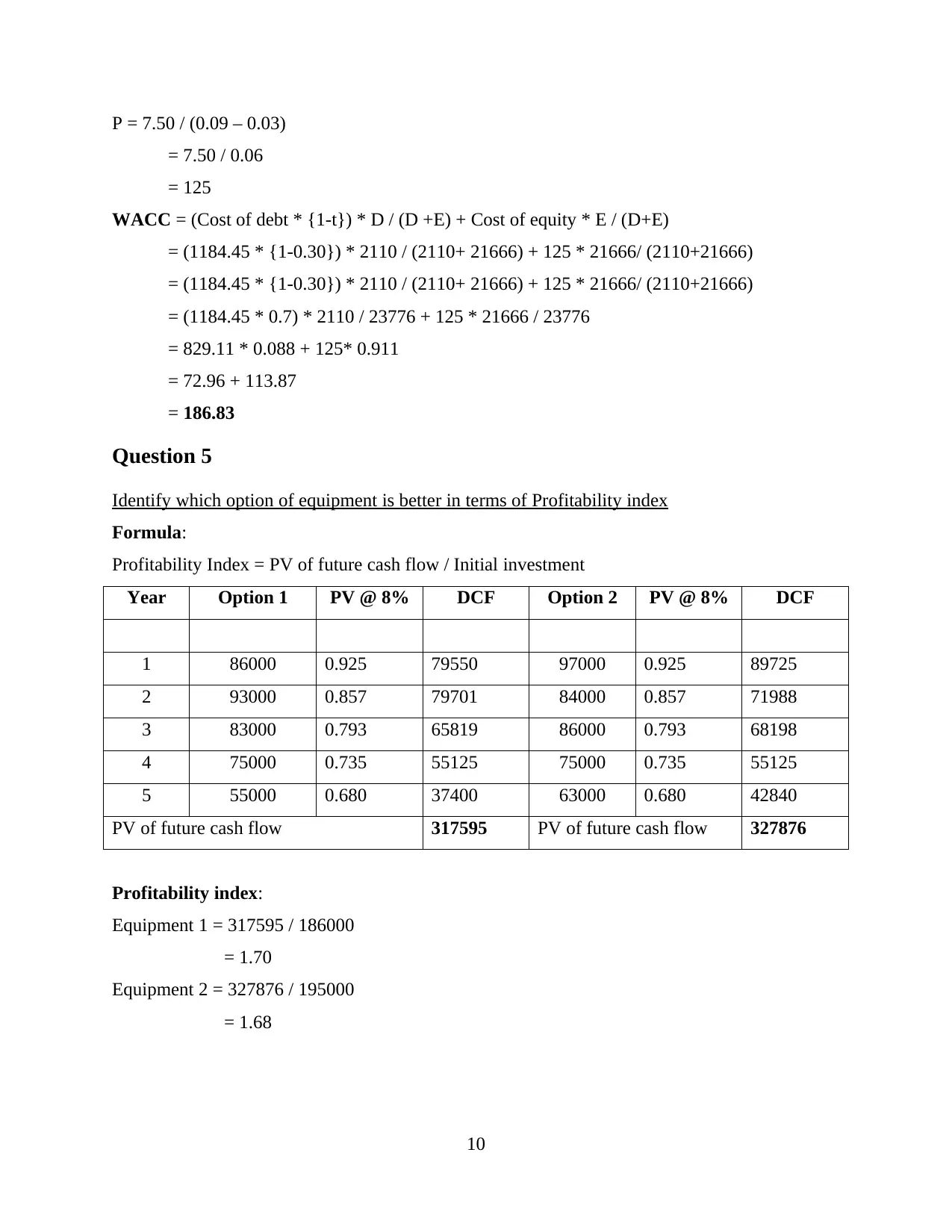
P = 7.50 / (0.09 – 0.03)
= 7.50 / 0.06
= 125
WACC = (Cost of debt * {1-t}) * D / (D +E) + Cost of equity * E / (D+E)
= (1184.45 * {1-0.30}) * 2110 / (2110+ 21666) + 125 * 21666/ (2110+21666)
= (1184.45 * {1-0.30}) * 2110 / (2110+ 21666) + 125 * 21666/ (2110+21666)
= (1184.45 * 0.7) * 2110 / 23776 + 125 * 21666 / 23776
= 829.11 * 0.088 + 125* 0.911
= 72.96 + 113.87
= 186.83
Question 5
Identify which option of equipment is better in terms of Profitability index
Formula:
Profitability Index = PV of future cash flow / Initial investment
Year Option 1 PV @ 8% DCF Option 2 PV @ 8% DCF
1 86000 0.925 79550 97000 0.925 89725
2 93000 0.857 79701 84000 0.857 71988
3 83000 0.793 65819 86000 0.793 68198
4 75000 0.735 55125 75000 0.735 55125
5 55000 0.680 37400 63000 0.680 42840
PV of future cash flow 317595 PV of future cash flow 327876
Profitability index:
Equipment 1 = 317595 / 186000
= 1.70
Equipment 2 = 327876 / 195000
= 1.68
10
= 7.50 / 0.06
= 125
WACC = (Cost of debt * {1-t}) * D / (D +E) + Cost of equity * E / (D+E)
= (1184.45 * {1-0.30}) * 2110 / (2110+ 21666) + 125 * 21666/ (2110+21666)
= (1184.45 * {1-0.30}) * 2110 / (2110+ 21666) + 125 * 21666/ (2110+21666)
= (1184.45 * 0.7) * 2110 / 23776 + 125 * 21666 / 23776
= 829.11 * 0.088 + 125* 0.911
= 72.96 + 113.87
= 186.83
Question 5
Identify which option of equipment is better in terms of Profitability index
Formula:
Profitability Index = PV of future cash flow / Initial investment
Year Option 1 PV @ 8% DCF Option 2 PV @ 8% DCF
1 86000 0.925 79550 97000 0.925 89725
2 93000 0.857 79701 84000 0.857 71988
3 83000 0.793 65819 86000 0.793 68198
4 75000 0.735 55125 75000 0.735 55125
5 55000 0.680 37400 63000 0.680 42840
PV of future cash flow 317595 PV of future cash flow 327876
Profitability index:
Equipment 1 = 317595 / 186000
= 1.70
Equipment 2 = 327876 / 195000
= 1.68
10

On the basis of profitability index, equipment 1 is better because it has high value in
comparison to equipment 2. There are very little different among both but still select second
option to invest which higher cash flow in comparison to initial investment.
Best option on the basis of discounted pay back method
Year Equipment 1 CCF Equipment 2 CCF
0 $186,000 - $195,000 -
1 86000 86000 97000 97000
2 93000 179000 84000 181000
3 83000 262000 86000 267000
4 75000 337000 75000 342000
5 55000 390000 63000 405000
Formula:
Payback period = Year before full recovery + Unrecovered amount / Cash flow
Equipment 1 = 2 + 7000 / 83000
= 2 + 0.084
= 2.084 years
Equipment 2 = 2 + 14000 / 86000
= 2 + 0.16
= 2.16 years
On the basis of discounted payback method, Bunnings Ltd should invest in first option
that is Equipment 1. It has lower payback period in comparison to Equipment 2.
Question 6
Calculate the ex-dividend price tomorrow morning
D = Dividend
TD = Tax on Dividend
TCG = Tax on capital gain
Formula:
Ex-Dividend price = D (1-TD) / (1-TCG)
Ex-Dividend price = 6 (1- 0.25) / (1- 0.30)
11
comparison to equipment 2. There are very little different among both but still select second
option to invest which higher cash flow in comparison to initial investment.
Best option on the basis of discounted pay back method
Year Equipment 1 CCF Equipment 2 CCF
0 $186,000 - $195,000 -
1 86000 86000 97000 97000
2 93000 179000 84000 181000
3 83000 262000 86000 267000
4 75000 337000 75000 342000
5 55000 390000 63000 405000
Formula:
Payback period = Year before full recovery + Unrecovered amount / Cash flow
Equipment 1 = 2 + 7000 / 83000
= 2 + 0.084
= 2.084 years
Equipment 2 = 2 + 14000 / 86000
= 2 + 0.16
= 2.16 years
On the basis of discounted payback method, Bunnings Ltd should invest in first option
that is Equipment 1. It has lower payback period in comparison to Equipment 2.
Question 6
Calculate the ex-dividend price tomorrow morning
D = Dividend
TD = Tax on Dividend
TCG = Tax on capital gain
Formula:
Ex-Dividend price = D (1-TD) / (1-TCG)
Ex-Dividend price = 6 (1- 0.25) / (1- 0.30)
11
You're viewing a preview
Unlock full access by subscribing today!
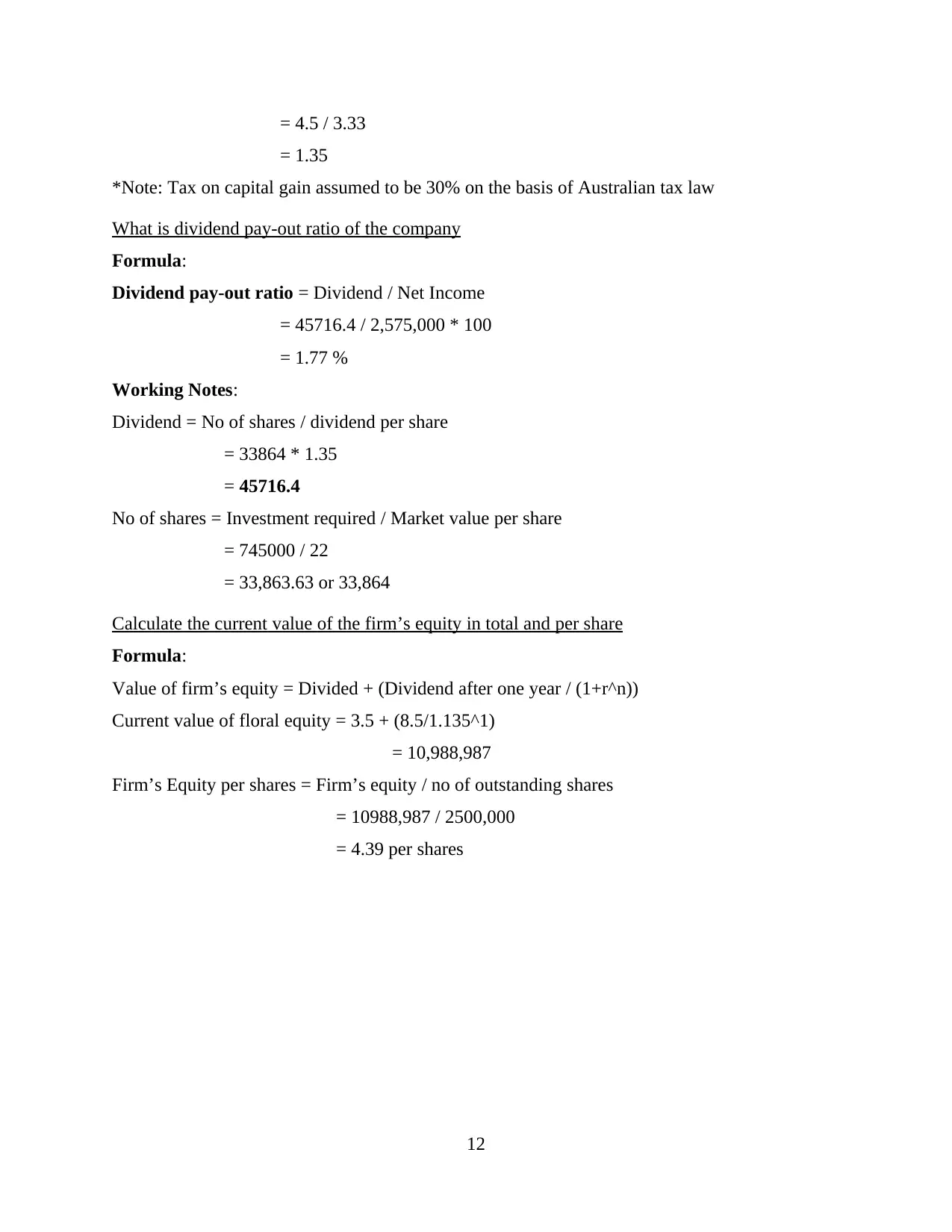
= 4.5 / 3.33
= 1.35
*Note: Tax on capital gain assumed to be 30% on the basis of Australian tax law
What is dividend pay-out ratio of the company
Formula:
Dividend pay-out ratio = Dividend / Net Income
= 45716.4 / 2,575,000 * 100
= 1.77 %
Working Notes:
Dividend = No of shares / dividend per share
= 33864 * 1.35
= 45716.4
No of shares = Investment required / Market value per share
= 745000 / 22
= 33,863.63 or 33,864
Calculate the current value of the firm’s equity in total and per share
Formula:
Value of firm’s equity = Divided + (Dividend after one year / (1+r^n))
Current value of floral equity = 3.5 + (8.5/1.135^1)
= 10,988,987
Firm’s Equity per shares = Firm’s equity / no of outstanding shares
= 10988,987 / 2500,000
= 4.39 per shares
12
= 1.35
*Note: Tax on capital gain assumed to be 30% on the basis of Australian tax law
What is dividend pay-out ratio of the company
Formula:
Dividend pay-out ratio = Dividend / Net Income
= 45716.4 / 2,575,000 * 100
= 1.77 %
Working Notes:
Dividend = No of shares / dividend per share
= 33864 * 1.35
= 45716.4
No of shares = Investment required / Market value per share
= 745000 / 22
= 33,863.63 or 33,864
Calculate the current value of the firm’s equity in total and per share
Formula:
Value of firm’s equity = Divided + (Dividend after one year / (1+r^n))
Current value of floral equity = 3.5 + (8.5/1.135^1)
= 10,988,987
Firm’s Equity per shares = Firm’s equity / no of outstanding shares
= 10988,987 / 2500,000
= 4.39 per shares
12
Paraphrase This Document
Need a fresh take? Get an instant paraphrase of this document with our AI Paraphraser
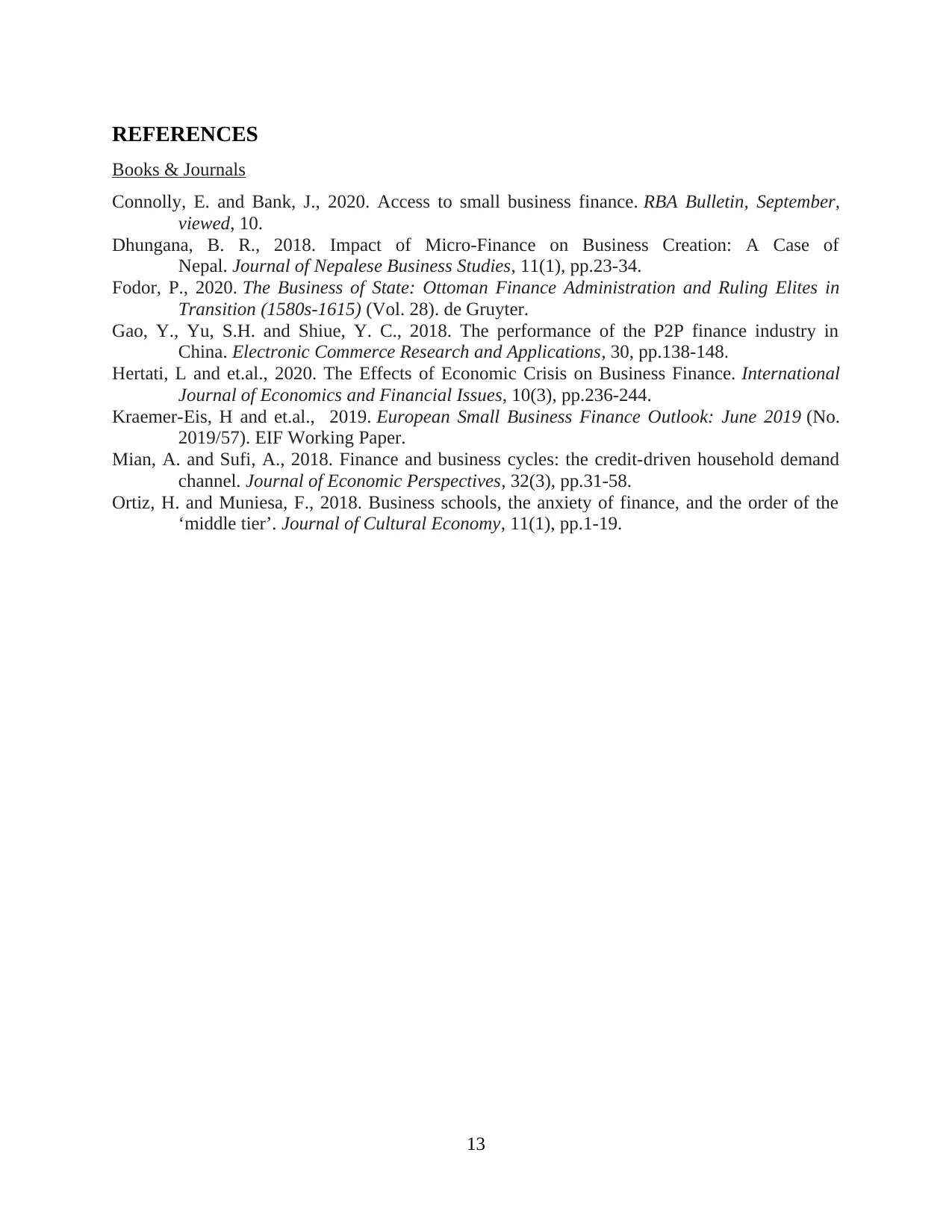
REFERENCES
Books & Journals
Connolly, E. and Bank, J., 2020. Access to small business finance. RBA Bulletin, September,
viewed, 10.
Dhungana, B. R., 2018. Impact of Micro-Finance on Business Creation: A Case of
Nepal. Journal of Nepalese Business Studies, 11(1), pp.23-34.
Fodor, P., 2020. The Business of State: Ottoman Finance Administration and Ruling Elites in
Transition (1580s-1615) (Vol. 28). de Gruyter.
Gao, Y., Yu, S.H. and Shiue, Y. C., 2018. The performance of the P2P finance industry in
China. Electronic Commerce Research and Applications, 30, pp.138-148.
Hertati, L and et.al., 2020. The Effects of Economic Crisis on Business Finance. International
Journal of Economics and Financial Issues, 10(3), pp.236-244.
Kraemer-Eis, H and et.al., 2019. European Small Business Finance Outlook: June 2019 (No.
2019/57). EIF Working Paper.
Mian, A. and Sufi, A., 2018. Finance and business cycles: the credit-driven household demand
channel. Journal of Economic Perspectives, 32(3), pp.31-58.
Ortiz, H. and Muniesa, F., 2018. Business schools, the anxiety of finance, and the order of the
‘middle tier’. Journal of Cultural Economy, 11(1), pp.1-19.
13
Books & Journals
Connolly, E. and Bank, J., 2020. Access to small business finance. RBA Bulletin, September,
viewed, 10.
Dhungana, B. R., 2018. Impact of Micro-Finance on Business Creation: A Case of
Nepal. Journal of Nepalese Business Studies, 11(1), pp.23-34.
Fodor, P., 2020. The Business of State: Ottoman Finance Administration and Ruling Elites in
Transition (1580s-1615) (Vol. 28). de Gruyter.
Gao, Y., Yu, S.H. and Shiue, Y. C., 2018. The performance of the P2P finance industry in
China. Electronic Commerce Research and Applications, 30, pp.138-148.
Hertati, L and et.al., 2020. The Effects of Economic Crisis on Business Finance. International
Journal of Economics and Financial Issues, 10(3), pp.236-244.
Kraemer-Eis, H and et.al., 2019. European Small Business Finance Outlook: June 2019 (No.
2019/57). EIF Working Paper.
Mian, A. and Sufi, A., 2018. Finance and business cycles: the credit-driven household demand
channel. Journal of Economic Perspectives, 32(3), pp.31-58.
Ortiz, H. and Muniesa, F., 2018. Business schools, the anxiety of finance, and the order of the
‘middle tier’. Journal of Cultural Economy, 11(1), pp.1-19.
13
1 out of 14
Related Documents
Your All-in-One AI-Powered Toolkit for Academic Success.
+13062052269
info@desklib.com
Available 24*7 on WhatsApp / Email
![[object Object]](/_next/static/media/star-bottom.7253800d.svg)
Unlock your academic potential
© 2024 | Zucol Services PVT LTD | All rights reserved.




